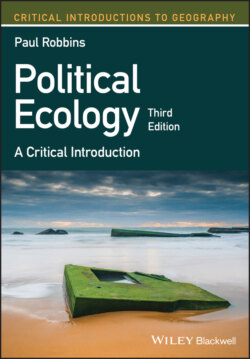Читать книгу Political Ecology - Paul Robbins - Страница 28
The target of explanation
ОглавлениеOf course, each of these theses actually seeks to explain something somewhat different. While degradation and marginalization offers an explanation of why environmental systems change (e.g., because of capital accumulation), environmental subjectivity research seeks to explain why social identities change (e.g., because of transformed environmental institutions). This diversity of targets for explanation has been the source of some confusion in the field (Vayda 2009; Vayda and Walters 1999) and reflects its historic development.
Research linking environmental change to political and economic marginalization emerged earliest, in the 1980s, querying links between the declining conditions of rain forests, cotton yields, or even workers' bodies and the integration into the global political economy (see Chapter 8). The problematic effects of global and regional conservation efforts, including World Heritage Sites, national parks, and biodiversity zones, became of increasing apparent in the 1990s, and political ecology on the topic has benefited from a growing interest later, in the 1990s and 2000s (Chapter 9). Interest in environmental conflict soon followed, as many environmental issues became increasingly politicized in both regional contexts, from Love Canal to the Amazonian rainforest, as well as global ones, with the emergence of global agreements and debates on climate and biodiversity (Chapter 10). Interest in the new environmental activism and identities grew from all of the issues above, and was placed squarely on the agenda by local people themselves, including movements of Andean smallholders, the Zapatistas, chipko, and a host of other movements (Chapter 11). An interest in political objects and agents is the most recent addition to debate in political ecology, rooted in its deep historical materialism, but also in a very recently emerging twenty‐first century concern for the way the non‐human world impinges on the human one (Chapter 12). These many topics and concerns overlap, and, as I hope to show by the end of the book, a coherent set of answers to these questions is beginning to achieve something of a consensus.
Moreover, in their linkages to local communities and NGOs, political ecologists, whether they are more interested in the biophysical or social aspects of a problem, have helped to build practical, detailed, integrated, empirical databases on all these diverse issues, recording land covers, farming practices, wildlife management systems, technological innovations and diffusions, local folk tales and oral histories, and informal markets and economies. These basic empirical findings help communities make decisions, aid in advocacy for social and environmental causes, and serve as a record to future scholars about the way things looked at the dawn of the twenty‐first century.
The value of this last contribution, providing an historical record, is not a trivial one. Much of what we know about the political economy of the environment is bequeathed to us by political ecologists of previous generations. Indeed, political ecology can arguably said to be very old, since nineteenth‐ and twentieth‐century environmental research in geography, anthropology, and allied natural and social sciences has a long critical tradition. Even before a semi‐coherent body of political ecological theory emerged in the late twentieth century, many explicitly political practitioners emerged from the ranks of field ecologists, ethnographers, explorers, and other researchers. These represent the deep roots of the field.
